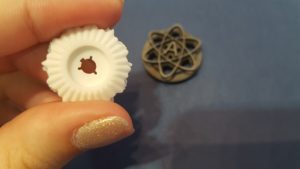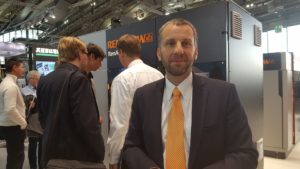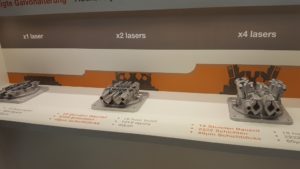 Frankfurt played host from November 14th through 17th to tens of thousands of members of the 3D printing community. According to the organizers behind formnext 2017, more than 21,492 attendees walked the two halls making up this year’s event, visiting with 470 exhibiting companies for conversations spanning booths, conference presentations, hallway encounters, scheduled interviews, impromptu gatherings, after-hours events, coffee catch-ups, and late-night kebabs. Energy remained high across Messe Frankfurt for the four-day event, as even the typically quieter last day continued to draw international visitors together, with conversations continuing even as carpets began to be rolled up to close the trade show.
Frankfurt played host from November 14th through 17th to tens of thousands of members of the 3D printing community. According to the organizers behind formnext 2017, more than 21,492 attendees walked the two halls making up this year’s event, visiting with 470 exhibiting companies for conversations spanning booths, conference presentations, hallway encounters, scheduled interviews, impromptu gatherings, after-hours events, coffee catch-ups, and late-night kebabs. Energy remained high across Messe Frankfurt for the four-day event, as even the typically quieter last day continued to draw international visitors together, with conversations continuing even as carpets began to be rolled up to close the trade show.
“The numbers show just how successful formnext 2017 was: In our third year, the sheer amount of world premieres we hosted, and the huge gains we saw in exhibitors and visitors bolstered formnext’s reputation not only as the industry’s leading exhibition, but as a key source of inspiration for the complete sector,” said Sascha F. Wenzler, Vice President for formnext at event organizer Mesago Messe Frankfurt GmbH.
We’ve been following the avalanche of announcements arising, as myriad companies used the visibility of the trade show to present their latest collaborations, hardware, software, materials, and more. On the show floor, new product introductions took priority with spotlit prominence and a few flashy curtain drops. With around a dozen scheduled meetings each day, including press conferences and interviews, my agenda for formnext 2017 was not only a logistical puzzle, but an engaging and almost information-overloading experience. It would have been impossible to see everything or talk to everyone I had hoped to, but by the end of four days I was still among those who had lost their voice from trying to make the rounds as much as possible.
Through an engaging several days of 3D printing chats, as ever certain themes emerged across formnext 2017. As this show has become entrenched as a must-see on the annual additive manufacturing events calendar, it is further emerging as a bellwether on the state of the industry — and the industry, as evidenced by the industrial focus of this past week, is maturing.
As Amit Dror, CEO of innovative Israeli company Nano Dimension, noted as we chatted during the show, among the most visible aspects of this year’s conference was the growth inherent year-over-year of the industry.
“There has been a noticeable trend,” Dror said, tracing back. “This event started out a few years ago, where exhibitors would say, ‘Check out my amazing technology.’ Today, though, it is, ‘Look at these applications.’ This shows that the reality is growing. The entrance of big-name players has had a big impact as they have aligned with the industry over the last few years. Seeing this growth, we are past the hype, as the more established companies are showing applications, emphasizing value, and elaborating how they fit in the working environment.”
For its part, Nano Dimension was not exhibiting at formnext again this year; rather, members of the company were spread across other international events, attending Munich at productronica, where their DragonFly 2020 Pro 3D printer won the show’s Innovation Award, as well as IDTechEx Show in Santa Clara, California. Dror journeyed to Frankfurt to join with colleagues including board member Avi Reichental, who was also supporting Nexa3D and the industrial efforts and increasing partnerships of XYZprinting. Speaking with Reichental about his latest efforts in the industry, the collaborative growth underlying the future of 3D printing was in focus.
“We are bringing together cutting-edge additive manufacturing with experienced endeavors, all driven by experts,” Reichental explained of his efforts including those with Techniplas and Xponential Works. “We are not leaving early-stage companies to figure it all out on their own; there is a hunger in the industry for this now. We have created an amazing ecosystem in which everybody wins and shares in case studies.”
The spirit of ‘everybody wins’ was a running theme throughout the week indeed, as many executives highlighted the increasingly critical nature of collaboration. Along with the growth of formnext as seen through sheer numbers of visitors was a closer look at the makeup of this year’s attendees; as I spoke with Hugo da Silva, Vice President of Additive Manufacturing at DSM, he noted that it was “great to see” a significant uptick in end users coming by the booth. DSM has been enhancing its foothold in 3D printing with a more united business plan to focus on the industry.
“There is a strong belief in partnerships in the industry, as it is moving from prototyping to production; there is a combined effort… Let’s work together to make an application work. This is a benefit for DSM and for the whole industry,” da Silva said, also underscoring the increase in presence from other global materials companies at the show and in the industry.
Global players are indeed strengthening their positioning across the industry, as partnerships with big names benefit the spread of innovation. Frank Herzog, Founder and CEO of Concept Laser, explained that as operations grew his company began to focus on the search for the right “big partner” to continue growth in metal additive manufacturing. In 2015, that search began in earnest, leading to the company’s majority acquisition in December 2016 by GE.
“Since then, a lot is different. We are running very fast,” Herzog told me as we talked shortly after the unveiling of the highly anticipated Project A.T.L.A.S. “We have joined expertise in machine building, and really started to work together. We are doing this at a very fast pace… There will be a new chapter in powder bed additive manufacturing.”
Even when discussing specific advances in technologies, each conversation led well beyond lasers or even materials to look into end-use applications — real-world usage and customers are absolutely in focus across the board. XJet, which introduced the new Carmel additive manufacturing system at the show, underscored the importance of customers, including the Carmel’s first installations in Germany and Ohio, as well as internal growth to support activity.
“The printer is the way of making the final product, which is most interesting to our customers… We put in a huge amount of effort to make this effortless to our customers. For the creation of complex geometries, we want the experience for the customer to be that they design the file and press print, then get what they need. When I see new technology released that makes life easier for the customer, it makes me happy. The final part, this is what matters,” XJet CEO Hanan Gothait explained when we sat down during the show. “We need to find the right partners, this is very important.”
As more developments lead toward production-scale additive manufacturing, exhibitors at the show were also keen to discuss the ways in which they have been addressing limitations in existing technologies. The introduction of a four-laser metal 3D printing system from Renishaw, for example, highlighted what Robin Weston, the company’s Marketing Manager, Additive Manufacturing Products Division, pointed to as a three-to-four-fold increase in productivity for about 1.5x the capital cost without an increase in the footprint.
“The cost of change has to have substantial reward,” Weston told me, underscoring a common barrier to entry into additive manufacturing and adoption of new technologies. “We are addressing applications that were previously uneconomical, processes that had been too slow, as well as other limitations. Part geometries and metal processes must be addressed; technology must be stable, repeatable, and controlled.”
Several companies have been addressing the market the best way they knew how — by providing their own tools directly to external users. Sculpteo, which introduced its Fabpilot software solution this week, has been looking to share expertise directly from the source. Fabpilot, company CEO and Co-Founder Clément Moreau explained during a demonstration of the new offering, presents a “collaboration between the designer and the customer.”
“This software was built to survive what we see every day,” Moreau said, as the company’s internal use encompasses “new people, many people, working in two factories on two different continents, able to share tools.”
Developing tools and sharing expertise from direct experience allows for deep-seated knowledge to spread more thoroughly into the 3D printing industry. Among those bringing deep experience into 3D printing is, of course, HP, which has been drawing from decades of 2D printing leadership for its storied foray into additive manufacturing. Speaking with Scott Schiller, Global Head of Customer and Market Development for HP Inc.’s 3D Printing business unit, and with John Dulchinos, Vice President, Global Automation and 3D Printing, Jabil, underscored the partner companies’ enduring focus on the market impact of industrial 3D printing.
“We can’t have the people making printers influence the people in the supply chain; everything we do has to make sense from an economics point of view,” Schiller said.
“Supply chain guys don’t care about the technology, they care about what makes sense,” Dulchinos continued. “This required a whole new way of ensuring that parts meet standards, that tolerances stack up. As amazing as 3D printing is, it’s not injection molding. A lot of work is required to go through the process to bring it to market.”
As HP is “doubling down” on efforts to industrialize 3D printing technology, company executives understand that this will not be an overnight process.
“We’re barely beginning, when we look at the potential,” Schiller told me. “I’ll be really excited to see this in 10 years.”
 In industry, 20,000-plus attendees to a week-long trade show is barely scratching the surface of participants. It is undeniable however, that additive manufacturing is attracting attention and rising engagement.
In industry, 20,000-plus attendees to a week-long trade show is barely scratching the surface of participants. It is undeniable however, that additive manufacturing is attracting attention and rising engagement.
3D printing on display in Frankfurt showcased maturing — note that is not to say mature — technologies making additive a very real part of manufacturing.
Discuss formnext 2017, and other 3D printing topics, at 3DPrintBoard.com or share your thoughts in the Facebook comments below.
[All photos: Sarah Goehrke]
Subscribe to Our Email Newsletter
Stay up-to-date on all the latest news from the 3D printing industry and receive information and offers from third party vendors.
Print Services
Upload your 3D Models and get them printed quickly and efficiently.
You May Also Like
3D Printing News Briefs, July 2, 2025: Copper Alloys, Defense Manufacturing, & More
We’re starting off with metals in today’s 3D Printing News Briefs, as Farsoon has unveiled a large-scale AM solution for copper alloys, and Meltio used its wire-laser metal solution to...
Etsy Design Rule Change Reduces Selection of 3D Printed Goods
Online marketplace Etsy has implemented a rule change requiring all 3D printed goods on the site to be original designs. The update to the site’s Creativity Standards states, ¨Items produced using...
Siraya Tech Introduces New Elastomer 3D Printing Materials, Including Foaming TPU
California company Siraya Tech, founded in 2019 with a focus on material science, customer focus, and agility, develops high-quality 3D printing materials that meet the needs of creators, hobbyists, and...
3D Printing News Briefs, April 12, 2025: RAPID Roundup
The news from last week’s RAPID+TCT in Detroit just keeps on coming! That’s why today’s 3D Printing News Briefs is another RAPID Roundup of more exciting announcements from the trade...










































